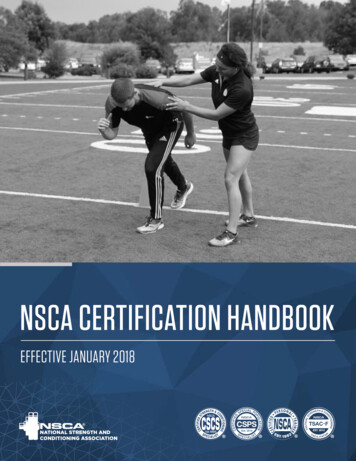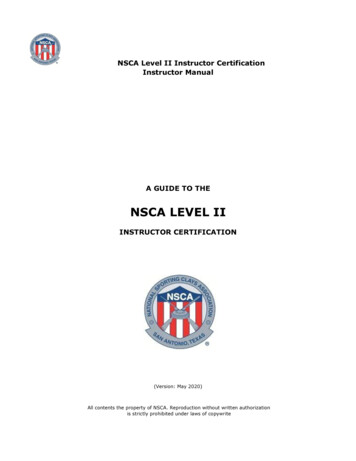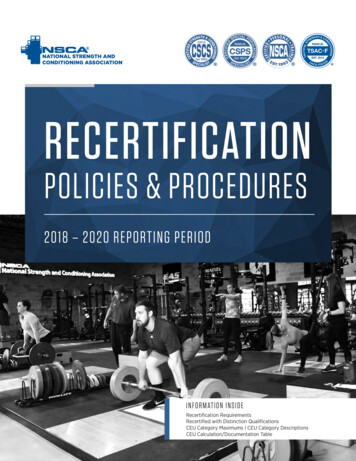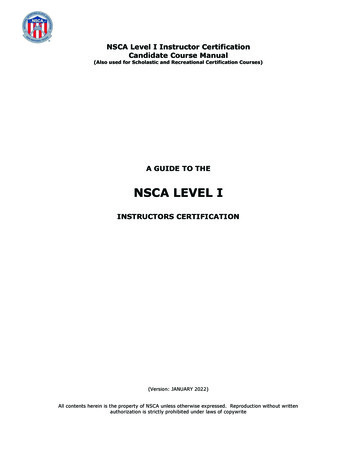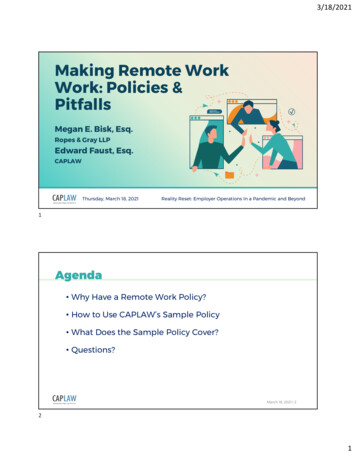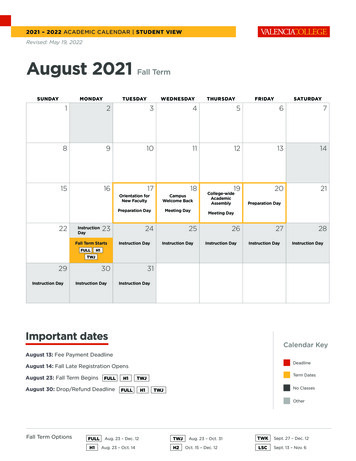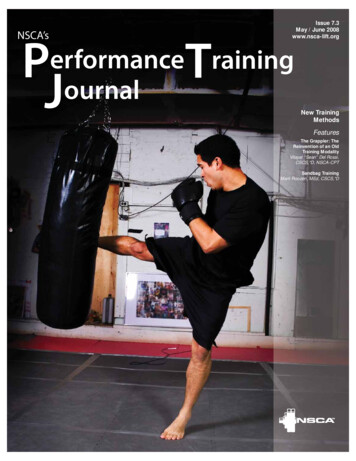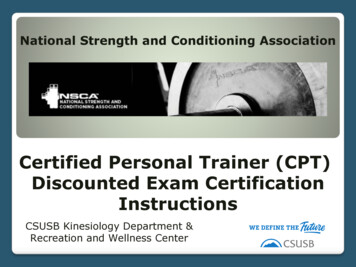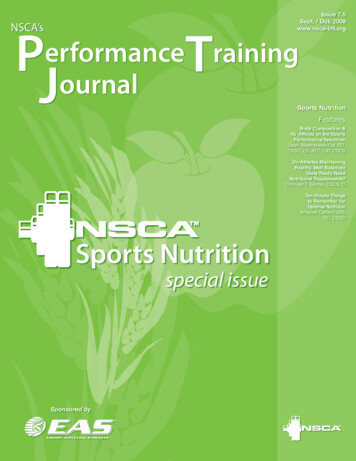
Transcription
NSCA’sPJerformanceournalTIssue 7.5Sept. / Oct. 2008www.nsca-lift.orgrainingSports NutritionFeaturesBody Composition &Its Affects on the SportsPerformance SpectrumDawn Weatherwax-Fall, RD,CSSD, LD, ATC, LAT, CSCSDo Athletes MaintainingHealthy, Well-BalancedDiets Really NeedNutritional Supplements?Donovan T. Santas, CSCS,*DTen Simple Thingsto Remember forOptimal NutritionAmanda Carlson, MS,RD, CSSDSports Nutritionspecial issueSponsored by
about thisPUBLICATIONNSCA’s Performance Training Journal is a publicationof the National Strength andConditioningAssociation(NSCA). Articles can be accessed online at www.nsca-lift.org/perform.All material in this publication is copyrighted by NSCA.Permission is granted forfree redistribution of each issue or article in its entirety.Reprinted articles or articlesredistributed online should beaccompanied by the following credit line: “This articleoriginally appeared in NSCA’sPerformance Training Journal, apublication of the NationalStrength and ConditioningAssociation. For a free subscription to the journal, browseto www.nsca-lift.org/perform.”Permission to reprint or redistribute altered or excerptedmaterial will be granted on acase by case basis; all requestsmust be made in writing to theeditorial office.NSCA MissionAs the worldwide authority onstrength and conditioning, wesupport and disseminate research–based knowledge andits practical application, to improve athletic performance andfitness.Talk to us Share your questions and comments. We want to hear fromyou. Write to NSCA’s Performance Training Journal Editor, NSCA, 1885 Bob JohnsonDrive, Colorado Springs, CO80906, or send email to torial Office1885 Bob Johnson DriveColorado Springs, Colorado 80906Phone: 1 719-632-6722TrainingEditorial Review PanelScott Cheatham, DPT, OCS, ATC,CSCS, NSCA-CPTEditorJay Dawes, MS, CSCS,NSCA-CPT,*DKeith Cinea, MA, CSCS,*D,NSCA-CPT,*DMeredith Hale-Griffin, MS, CSCSAssistant EditorMichael Hartman, MS, CSCS,*DBrian Newman, MS, CSCSMark S. Kovacs, MEd, CSCSSponsorship InformationRichard Irwinemail: rirwin@nsca-lift.orgDavid Pollitt, CSCS,*DMatthew Rhea, PhD, CSCSDavid Sandler, MS, CSCS,*DBrian K. Schilling, PhD, CSCSMark Stephenson, ATC, CSCS,*DDavid J. Szymanski, PhD, CSCS,*DChad D. Touchberry, MS, CSCSJoseph M. Warpeha, MA, CSCS,*D,NSCA-CPT,*DThe views stated in the NSCA’sPerformance Training Journalare those of the authors, anddo not necessarily reflect thepositions of the NSCA.nsca’s performance training journal www.nsca-lift.org volume 7 issue 52
CONTENTStable ofsports nutritionBody Composition & Its AffectsTen Simple Things to6 on17the Sports PerformanceRemember for Optimal NutritionSpectrumDawn Weatherwax-Fall, RD, CSSD, LD,ATC, LAT, CSCSTake a closer look at body composition and itsaffect on performance. Included are recommendedguidelines and a discussion on different methods forpredicting body composition.Amanda Carlson, MS, RD, CSSDNutrition does not have to be complicated.These ten simple things can help you start eating better immediately.Athletes Maintaining10 DoHealthy, Well-Balanced DietsReally Need NutritionalSupplements?Donovan T. Santas, CSCS,*DThis article looks at the need for athletes to appropriately supplement a well-balanced, whole food-baseddiet for optimal nutrient levels, and discusses thecurrent use of supplements by athletes.departmentsGames4 MindLearning from OlympiansSuzie Tuffey Riewald, PhD,NSCA-CPTAs an athlete, you were undoubtedly one of the 4 billion people that watched the recent Olympic Gamesin Beijing. This article takes a look at some of the outstanding performances of the ’08 Olympics, and howproper mental skills played into the performances.8 Fitness FrontlinesG. Gregory Haff, PhD, CSCS,*D, FNSCAThe latest news from the field on milk ingestion andendurance performance, ß-alanine supplementationand body composition, whey protein supplementationand fat loss, and the effect of vitamin C and E supplementation on high intensity performance.The Gym13 InNutritionalQuality vs.Nutritional Quantity:Properly Fueling Athletes forOptimal PerformanceTable14 TrainingDoes Your DietPass Muster?Debra Wein, MS, RD, LDN,CSSD, NSCA-CPT,*DTake a look at five basic tenets for a good diet, andhow you can easily determine your caloric requirements.Of Prevention16 OunceRecognizing Disordered EatingHabits in AthletesJason Brumitt, MSPT, SCS, ATC/R,CSCS,*DThe prevalence of disordered eating in female athleteshas been estimated to be as high as 62%, whereas33% of male athletes may demonstrate behaviorsassociated with disordered eating. The purpose ofthis article is to present the signs and symptoms associated with disordered eating.Kyle Brown, CSCSLooking at the label does not always guarantee youare buying a nutritious product. This article discusseshow to look beyond the label and find foods that notonly are healthy, but can better fuel your performance.nsca’s performance training journal www.nsca-lift.org volume 7 issue 53
Mind Gamesabout theAUTHORSuzie Tuffey Riewaldreceived her degreesin Sport Psychology/Exercise Science fromthe University of NorthCarolina —Greensboro.She has worked for USASwimming as the SportPsychology and SportScience Director, and mostrecently as the AssociateDirector of Coachingwith the USOC whereshe worked with varioussport national governingbodies (NGBs) to developand enhance coachingeducation and training.Suzie currently worksas a sport psychologyconsultant to severalNGBs.Suzie Tuffey Riewald, PhD, NSCA-CPT,*DLearning From OlympiansAs an athlete, you were undoubtedly one of the 4billion people that watched the recent OlympicGames in Beijing. People across the globe tuned in towitness amazing athletic performances from a multitude of sports. While watching these phenomenalathletes perform, we cannot help but be “awed” by thephysical and technical prowess of these athletes who areable to do things most of us do not even dream about.What performance stands out in your mind? Many will immediately think of Michael Phelpswhen recalling the 2008 Olympic Games. He woneight gold medals, setting seven world records inthe process. The commentators talked often of hisphysique that is so suited to swimming and hisamazing technical skills. For some, it may be the marathoners who run subfive minute miles for 26.2 miles. Others may remember the gymnasts who have phenomenal body control and awareness. They perform athletic feats that seem beyond the realm ofthe physically possible, often times seeming to defygravity. All of the sports; shooting, wrestling, badminton,equestrian, soccer, volleyball, fencing, and so on offer examples of phenomenal physical feats.The physical, physiological, and technical prowess ofthe Olympians is, in many instances, quite evident. But,what else separates these athletes? Are there other skillsor characteristics that they possess? Let me give a fewexamples and you tell me the skills or characteristicsthat enable such astounding performances:Chen Ruolin, a 15-year-old diver competing in her firstOlympic Games, stood on the 10-meter platform getting ready for her last dive. She needed 9.5’s and 10’sto win the gold. In preparation for the dive, her movements indicated she was going through her dive in herhead then she walked to the edge of the platform, didnot hesitate, and dove. She nailed the dive and won theevent, scoring four perfect 10s and three 9.5s, despitethe pressure-filled internal and external environment.Unexpected tragedy struck the US men’s volleyballteam. The father-in-law of head coach Hugh McCutch-eon was stabbed and killed in a random act of violencewhile visiting a Beijing landmark just days before thestart of the Games. Consequently, the team was without their head coach for several matches and had to dealwith the emotional turmoil of losing someone who hadbeen very close to the team. The assistant coaches andathletes had to manage their emotions and maintain focus on the task at hand. The end result, they won gold,beating Brazil in four sets. Additionally, in the processof getting to the gold medal game, the US team had tofight through a number of 5-set matches where in anyone of them it would have been very easy just to “throwin the towel.” However, they consistently rose to meetthe challenge. Talk about maintaining focus through anemotional roller coaster.Michael Phelps’ drive for 8 gold medal could haveended very early were it not for the performance of histeammates on the 4x100 meter relay. Jason Lezak wasthe last swimmer on the relay team and entered the water 0.6 seconds behind the world record holder in the100 meter freestyle, Frenchman Alain Bernard had aninsurmountable lead for all intents and purposes. Lezaklost another 0.2 seconds to the French swimmer overthe first 50 meters of the race, only to swim nearly asecond faster over the final 50 meters—turning in thefastest relay split every recorded (46.07 seconds) whileleading the US to victory by 0.08 seconds. How spectacular was this feat and how much did the mental component come into play? In the individual 100 meterfreestyle, Lezak won the bronze with a time of 47.67—a full 1.7 seconds slower than his relay performance.While swimmers definitely benefit from the relay start,swimmers typically only swim several tenths of a second faster in the relay compared to the individual event.Clearly something else played into this phenomenal relay performance.Yes, mental skills certainly seemed to be a factor impacting performance. In their pursuit of excellence, theathletes used mental skills to manage their emotions,to deal with the environment, to maintain an effectivefocus, to enhance their performance. Do you manageperformance expectations? Are you able to deal withdistractions? Do you have a strong determination andcommitment?nsca’s performance training journal www.nsca-lift.org volume 7 issue 54
mind gamesLearning From OlympiansThe above are just a few examples to illustrate the psychological aspect Enough about other athletes, now it is your turn. As we have discussed,of performance. Research can shed further light. Numerous studies have the physical and technical strengths of elite athlete are often obvious. And,assessed the psychological characteristics of successful versus less success- as athletes, you work to develop your own physical and technical strengths.ful athletes. A summary of this research (1) suggests that more successful At the surface, mental skills of elite athletes may be less apparent but closerathletes are characterized by higher confidence, greater management of “inspection” reveals they exist. Are you also working to develop your menarousal, better concentration and focus, an in-control attitude, positive tal skills? Are you equipping yourself with the skills to manage the chalthoughts and imagery, greater determination and commitment, and the lenges inherent in sport? If not, now is the time to begin. use of mental skills such goal setting, imagery, coping strategies and mental preparation plans.ReferencesSome of these skills were evident, directly or indirectly, in the athletescompeting in the Olympic Games. Other skills are more difficult to observe or infer so it would take talking to the athletes to determine whatwas going on internally.Speed1. Williams, JM and Krane, V. Psychological characteristics of peakperformance. In: Applied sport psychology: Personal growth to peakperformance. J.M. Williams (Ed.), Mountain View, CA: Mayfield.When Speed andAgility Are Important,Turn To The LeadersIn Sports Performance.Agility Quality Equipment Expert StaffFast Shipping Educational SeminarsRequest Your 2008PERFORM BETTERCatalogQuicknessCall 800-556-7464www.performbetter.com30-18866 Speed SC 7.25x4.34.ind1 1nsca’s performance training journal www.nsca-lift.org volume 7 issue 512/6/07 3:45:55 PM5
featuresports nutritionBody Composition andIts Affect on the SportsPerformance Spectrumabout theAUTHORDawn Weatherwax-Fallis a Registered/LicensedDietitian with a specialtyin Sports Nutritionand Founder of SportsNutrition 2Go. She isalso a Board CertifiedSpecialist in SportsDietetics. In addition, sheis an Athletic Trainer witha Certification in Strengthand Conditioning fromThe National Strength andConditioning Association.Therefore, she bringsa comprehensive andunique understanding ofthe athlete’s body, and itsnutritional needs, to thoseinterested in achievingspecific performancegoals and optimalhealth. WeatherwaxFall is also the authorDawn Weatherwax-Fall, RD, CSSD, LD, ATC, LAT, CSCSHaving a certain body fat to muscle mass ratio isrelated to athletic performance. Research hasshown that correct portion of muscle mass increasesstrength, power, and agility (8,9). Table 1 (see nextpage) provides recommend body fat percentages forboth men and women.3. When you are evaluating body fat percentages thechallenge is not to just evaluate the percent body fatnumber but to also evaluate the lean weight number.Even though you may have the appropriate body fatpercentage for your sport, you may still have roomfor improvement if you continue to gain lean mass.However, to gain lean muscle it is not just about the exercise protocol but nutritional intake and timing (2,7).Research shows three out of four student athletes maynot be getting enough to eat. It also shows that 70% ofthe women and 73% of the men are not getting enoughtotal calories, only 81% of the women and 90% of themen are consuming enough carbohydrates, and just68% of the women and 81% of the men are eatingenough protein based on USDA guidelines. Intakes ofsalt, total fat, saturated fat, and cholesterol often exceed recommendations, even in diets deficient in majorcomponents (4).4. When an athlete has encountered a severe injurywhere rehabilitation will take several months, measuring body composition on a monthly basis can bea tool to minimize a gain in body fat. Athletes cangain body fat quickly when activity has been limited and eating habits are poor. It is difficult to getan athlete back to “full go” if they have lost muscleand gained body fat.To help you achieve your goals, you should know yourbody composition. But body composition is muchmore than a body fat percentage number. Below aredifferent ways the measurement can be utilized.of The Official SnackGuide for BeleagueredSports Parents and TheComplete Idiot’s Guideto Sports Nutrition. Sheis an Official Speakerfor the Gatorade SportsScience Institute and onthe approval speaker listfor the NCAA. She hasalso been featured ontelevision shows including:Good Morning America,MSNBC, Geraldo Rivera,and Fox News.1. Knowing what percent body fat assists in the typeof fuel mixture an athlete needs. If an athlete hasa higher body fat they usually need fewer caloriesand fewer carbohydrates. The opposite is true ifthe athlete has a low body fat. They usually needmore calories and carbohydrates due to more leanweight.5. Body Composition testing can be a reassurance test.Many female athletes believe when they gain weight,they are gaining fat. Also an athlete can exchangefat at the same rate they gain muscle so the scale isnot displaying the positive exchange.6. Because female athletes are more vulnerable todeveloping an eating disorder (5), having biyearlybody composition tests can detect any significantchanges. These changes could shed light on an unhealthy behavior with food.The best ways to measure body composition are by hydrostatic weighing, Dexa Scan or Bod Pod testing. However many people do not have access or the funds to usethese methods. The next best step is to use Lange skinfold calipers. They are easy to use, easy to learn, andvery affordable. However you want to make sure you2. In any strength and conditioning or specialized nu- take the time and follow strict protocols to ensure accutrition program there needs to be a way to measure racy (3). Take a minimum of three tests at each site andits effectiveness. Body composition testing is an im- have at least two numbers that are within a millimeter.portant measurement tool since most athletes want If you do not, then keep retesting the site until youto gain muscle, lose fat, or do both.do. The last thing you want is the body fat percentageto increase due to poor measuring techniques. Lastlynsca’s performance training journal www.nsca-lift.org volume 7 issue 56
Body Composition and Its Affects of the Sports Performance Spectrumyou want to avoid going the easy route and buya bioempedance device. These devices can beanywhere from 6 – 10% off because these techniques depend on the athletes hydration status(6). These tools start off by measuring how fastthe current runs through the body. The morehydrated the athlete the lower the body fat willregister. The more dehydrated the athlete is thehigher the body fat will measure.Body Composition testing is not just aboutmeasuring fat. It can be a very effective tool formenu planning, monitoring progress, improvingcurrent athletic status, part of a rehabilitationprotocol, offering encouragement, and findingirregularities in behavior. Now that is a tool. References1. ACSM’s Guidelines for Exercise TestingPrescription. American College of SportsMedicine,7th Edition. Philadelphia: LippincottWilliams & Wilkins. (2005).2. Biolo, G, Williams, BD, Fleming, RY, and Wolfe,RR. Insulin action on muscle protein kineticsand amino acid transport during recovery afterresistance exercise. Diabetes, 48:949 – 957.(1999).3. Heyward, VH, Wagner, DR. Applied BodyComposition Assessment. Champaign, IL:Human Kinetics. (2004).ClassificationWomenMenEssential10 – 12%2 – 4%Athletes14 – 20%6 – 13%Fitness21 – 24%14 – 17%Acceptable25 – 31%18 – 25%Plus32% plus25% plus4. Hinton, P, Sanford, T, Davidson, MM, Yakushko,O, and Beck, N. Nutrient intake and dietarybehaviors of male and female collegiateathletes. Inter J of Sports Nutrition and ExerciseMetabolism, 14: 389 – 390. (2004).5. Kirk, G, Singh, K, and Getz H. Risk of EatingDisorders among female college athletes andnonathletes. Journal of College Counseling,4(2): 122 – 132. (2001).6. McArdle, W, Katch, F, Katch, V. ExercisePhysiology. (4th Edition). Philadelphia: LippincottWilliams & Wilkins. (2006).Table 1General Body FatPercentage Category (1)carbohydrate supplement enhances muscleprotein anabolism after resistance exercise. J.Appl. Physiol, 88:386 – 392. (2000).8. Spaniol FJ. Physiological predictors of batspeed and throwing velocity in adolescentbaseball players (Abstract). Journal of Strengthand Conditioning Research, 16(4): 1 – 18.(2002).9. Spaniol FJ. Predicting throwing velocity incollege baseball players (Abstract). Journalof Strength and Conditioning Research, 11(4):286. (1997).7. Rasmussen B, Tipton, KD, Miller, SL, Wolf, SE,and Wolfe, RR. An oral essential amino acid-nsca’s performance training journal www.nsca-lift.org volume 7 issue 57
FitnessFrontlinesG. Gregory Haff, PhD, CSCS,*D, FNSCAabout theAUTHORDoes Milk Ingestion ImproveEndurance Performance?G. Gregory Haff is anassistant professor inthe Division of ExercisePhysiology at the MedicalSchool at West VirginiaUniversity in Morgantown,WV. He is a member ofthe National Strength andConditioning Association’sBoard of Directors. He isa Fellow of the NationalStrength and ConditioningAssociation. Dr. Haffreceived the NationalStrength and ConditioningAssociation’s YoungInvestigator Awardin 2001.One of the main effectors on the capacity to performprolonged exercise is the availability of carbohydrates.Many studies have reported that the ingestion of carbohydrates before and during exercise as an ergogenic toolmay improve performance. Many commercially available carbohydrate supplements are formulated in concentrations of 2 – 10%. Interestingly milk has a similarconcentration while containing similar electrolyte andmacronutrient breakdowns. Recently researchers fromLoughborough University in the United Kingdom compared the effects of water, carbohydrate electrolytes,and milk carbohydrate on exercise capacity. Eighthealthy men were randomly assigned a treatment orderwith each subject performing endurance trials with fourdifferent supplements. Each subject ingested 1.5 mL/kg body mass of plain water, a carbohydrate-electrolytebeverage, and low fat milk (0.1%) added glucose prior to the exercise bout and every 10 minutes during thebout. The exercise bout consisted of performing cycleergometry work at 70% of VO2peak until volitional exhaustion. There were no differences in the exercise duration between the four supplements, but the inclusionof milk or carbohydrate appeared to result in longerexercise durations when compared to the water condition. The carbohydrate-electrolyte beverage increasedexercise duration by 17.3 minutes, the milk conditionincreased exercise duration by 10 minutes, and the milk carbohydrate resulted in 9.5 minutes more exercisewhen compared to the water condition. There was alsono difference in the subjective feelings experienced during the exercise trial between the treatments. Taken collectively the results of this study suggest that the effectsof milk supplementation appear to be similar to that ofcarbohydrate electrolyte beverages.Lee, JK, Maughan, RJ, Shirreffs, SM, and Watson, P.Effects of milk ingestion on prolonged exercise capacityin young, healthy men. Nutrition 24:340 – 347. 2008.ß-Alanine Supplementationdoes not ImprovePerformance of BodyComposition After 10-weeksof Supplementation andResistance Training.Carnosine is a di-peptide which is synthesized in muscle and central nervous system tissue from histidine andß-alanine. ß-alanine supplementation and/or resistancetraining has recently been linked to increases in musclecarnosine concentrations. It has been postulated that increases in carnosine improved buffering capacity whichcorresponds to improvements in anaerobic and aerobicexercise performance. Very few studies have examinedthe effects of ß-alanine supplementation coupled withresistance training on muscle carnosine concentrationand performance. Therefore the aim of the present studywas to examine a 10-week resistance training programcoupled with the consumption of 6.4 g/day of ß-alanine.Twenty six physical education students were randomlydivided into a ß-alanine and a placebo supplementation group. All subjects resistance trained four days perweek for 10 weeks and took 6.4 g ß-alanine or placeboper day. Biopsies, performance, and body compositionwere assessed prior to and after the 10 week intervention. There were no significant increases in whole bodystrength between the ß-alanine ( 19.67%) and the placebo treatments ( 17.46). Additionally, no differencesin isokinetic strength were noted between the ß-alanine( 12.1%) and the placebo ( 12.6%). When body composition and body mass were examined there were nodifferences between the two treatments. The ß-alaninesupplemented group did express higher muscle carnosine concentrations after the 10 weeks of supplementation when compared to the placebo treatment. Basedupon these results it was concluded that supplementingthe diet and training with ß-alanine does not result inan ergogenic effect as indicated by markers of musclestrength and changes in body composition.Kendrick, IP, Harris, RC, Kim, HJ, Kim, CK, Dang, VH,Lam, TQ, Bui, TT, Smith, M, and Wise, JA. The effectsof 10 weeks of resistance training combined with betaalanine supplementation on whole body strength, forceproduction, muscular endurance and body composition.Amino Acids 34:547 – 554. 2008.nsca’s performance training journal www.nsca-lift.org volume 7 issue 58
Fitness FrontlinesWhey ProteinSupplementationIncreases Fat loss andSpares Lean Muscle inObese Subjects.Does Vitamin C andE SupplementationEffect High IntensityPerformance duringSoccer Training?Obesity is a worldwide epidemic that contrib- It is widely documented that exercise trainingutes to a multitude of health issues. One weight can increase the formation of markers of oxidamanagement method is manipulating the ra- tive stress. Vitamin C and E are two powerfultio of carbohydrates and protein in the diet. antioxidant molecules which can affect the forThrough manipulating the diet it is hoped that mation of markers of oxidative stress. Severala greater maintenance of lean body mass occurs studies have demonstrated the potential abilitywhile enhancing the decrease in body fat. One of vitamin C and E supplementation of markerspotential tool in this process is the use of whey of oxidative damage in humans. However, veryprotein supplementation. Based upon this line few studies have examined the effects of combinof reasoning the present study was designed to ing supplementation with training and how perexamine the effects of whey protein supplemen- formance may be impacted. Therefore the prestation on fat loss and lean body mass. One hun- ent study was to examine the effects of vitamindred and fifty eight subjects between the ages of C and E supplementation on markers of oxida20 – 50 years of age who had a bodymass index tive stress, muscle damage, and performance inbetween 30 – 42 kg/m2 were recruited for this elite soccer players. Ten male soccer players wereinvestigation. All subjects had their dietary in- randomly divided into two matched groups; 1)take reduced by 500 kcals per day and consumed 1000 mg vitamin C and 800 mg of vitamin Ea whey protein shake or isocaloric placebo 20 and 2) maltodextrine. All supplements were adminutes before breakfast and dinner each day ministered in a double blind fashion and werefor 12 weeks. Body fat and anthropometric mea- consumed in conjunction with the subject’ssurements were taken every four weeks. Both the regular diets. Training loads were identical forplacebo and whey protein groups significantly the three month intervention. There were nodecreased body mass. However, the whey pro- differences in the markers of oxidative stress betein group tended to lose more body fat ( 1.19 tween the two treatment groups. However, the– 1.52 kg), which corresponded to about 6.1% vitamin C and E group demonstrated significantof their body fat mass. Since a 5% reduction in reduced markers of muscle damage in responsefat mass has been linked to a reduced disease to the high intensity efforts associated with socrisk in obese patients this finding is considered cer training. Even though less muscle damageimportant. In addition to the fat mass loss the was noted there were no differences in actualwhey protein group tended to maintain more performance measures between the two treatlean body mass. Based upon these findings the ment groups.inclusion of whey protein supplements as partof a weight loss plan may result in more optimal Zoppi, CC, Hohl, R, Silva, FC, Lazarim, FL, Neto,JM, Stancanneli, M, and Macedo DV. Vitamin Closses of body fat when compared to simply reand E supplementation effects in professionalducing caloric intake.Frestedt, JL, Zenk, JL, Kuskowski, MA, Ward, LS,and Bastian, ED. A whey-protein supplementincreases fat loss and spares lean muscle inobese subjects: A randomized human clinicalstudy. Nutr Metab (Lond) 5:8. 2008.SportsNutritionProgramsoccer players under regular training. Journalof the International Society of Sports Nutritionpresented by3:37-44. 2006. www.nsca-lift.org/NSCASportsNutrition/nsca’s performance training journal www.nsca-lift.org volume 7 issue 59
featureabout theAUTHORsports nutritionDo Athletes MaintainingHealthy, Well-BalancedDiets Really NeedNutritional SupplementsDonovan T. SantasDonovan T. Santas, CSCS,*Dwas named Blue JaysAMajor League Strength& Conditioning Coachin January 2003 afterserving as minor leaguecoordinator since 2001.He graduated in 1999 fromthe University of WisconsinLa Crosse with a B.Sin Exercise and SportsScience, majoring inStrength and Conditioning.He is member of theNational Strength &Conditioning Association(NSCA) and sits on theboard of the ProfessionalBaseball Strength &Conditioning CoachesSociety (PBSCCS). In theoffseason, he resides inTampa, Florida with hiswife, and devotes his freetime to conducting youthathlete workshops onstrength & conditioningand sports performancenutrition.s a child how many times did you hear: “eat yourfruits and veggies!”? As an adult, particularly as anathlete, eating fruits and vegetables is one of the onlysignificant ways to get some of what the body needsfrom its food. Why? Because organically grown, antioxidant-rich fruits and vegetables represent one of theonly nutritious food sources readily available. Unfortunately, getting your well-balanced daily servings of nutrient-rich food is a difficult task as most commerciallyprocessed foods are stripped of nutritional value and,worse yet, potentially full of toxins due to overuse offertilizers, pesticides, and herbicides. This combinationof over-processing and contamination not only fills ourrestaurants but also our supermarkets with high-calorieand/or high-glycemic and low-nutrient food options.Therefore, you have to be more diligent than ever tomake quality food choices. And, as an athlete, to ensurepeak performance and to ward off chronic degenerativediseases, you need to appropriately supplement a wellbalanced, whole food-based diet for optimal nutrientlevels.In the world of serious and professional sports, supplements are arguably one of the most misunderstoodand overwhelming topics. Adding to the confusion isthe constant influx of the “next best thing” products,making too-good-to-be-true claims. Because athletesare always looking for an edge, they are often easy preyfor the billion-dollar supplement industry marketing gurus. So what exactly are supplements? Are theyreplacements for whole foods, as some manufacturerswould have you believe? By design, supplements shouldsupplement, filling in the nutritional gaps of a qualitydiet. Generally, these nutritional gaps are seen as a lackof vitamins, minerals, and antioxidants. However forathletes, a lack of foods that enhance metabolism andpreve
J.M. Williams (Ed.), Mountain View, CA: Mayfield. Call 800-556-7464 www.performbetter.com Request Your 2008 PERFORM BETTER Catalog Quality Equipment Expert Staff Fast Shipping Educational Seminars When Speed and Agility Are Important, Turn To The Leaders Agility In Sports Performance. Quickness Speed
